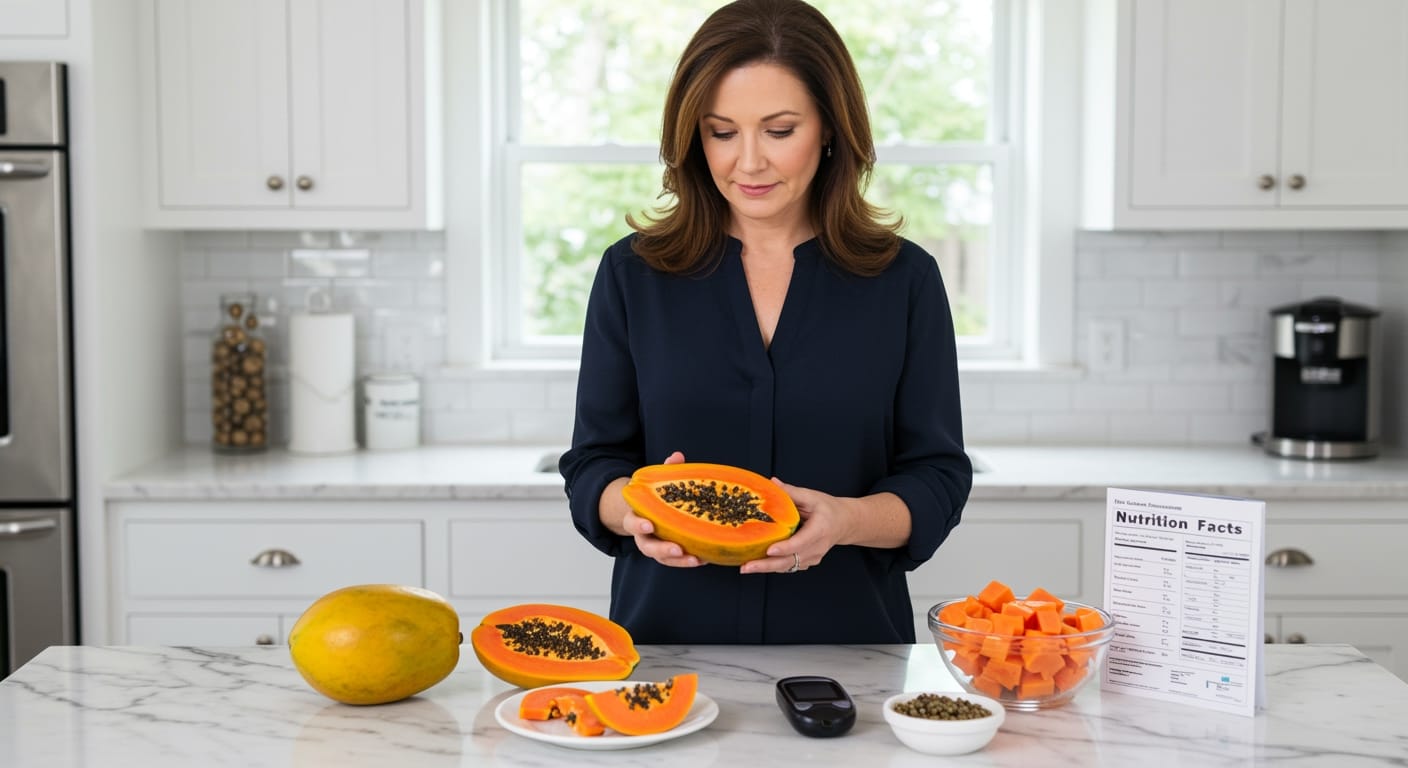✪ Key Takeaway: Papaya can be safely consumed by diabetics in moderate portions due to its low glycemic index and beneficial nutrients.
Introduction
You stare at the colorful papaya in your grocery cart and wonder if this tropical fruit will send your blood sugar soaring.
Many people with diabetes face this exact dilemma because they have heard conflicting information about fruit consumption and blood sugar control.
Hi, I am Abdur, your nutrition coach and today I am going to explain exactly how papaya affects your blood sugar levels and whether it deserves a place in your diabetes-friendly meal plan.
What Makes Papaya Different From Other Fruits?
Papaya stands out among fruits because of its unique nutritional profile that works favorably for blood sugar management.
This tropical fruit contains only 11 grams of carbohydrates per 100 grams, which is significantly lower than many popular fruits like bananas or grapes.
The glycemic index of papaya ranges between 56-60, placing it in the moderate category rather than the high-spike zone that diabetics typically avoid.
What makes papaya particularly interesting is its high fiber content of 2.5 grams per 100 grams, which slows down sugar absorption in your digestive system.
The fiber creates a protective barrier in your intestines that prevents rapid glucose spikes by forming a gel-like substance that delays carbohydrate breakdown.
Additionally, papaya contains natural enzymes like papain that support digestion and may help your body process nutrients more efficiently without causing dramatic blood sugar fluctuations.
✪ Fact: Papaya contains more vitamin C than oranges, providing 61mg per 100 grams compared to 53mg in oranges.
How Does Papaya Affect Your Blood Sugar Response?
When you eat papaya, your body processes its natural sugars differently than processed sweets or high-glycemic fruits.
The fructose content in papaya is relatively low compared to other tropical fruits, which means less stress on your liver during sugar metabolism.
Your pancreas responds to papaya consumption with a gradual insulin release rather than the sharp spike you might experience with refined sugars.
The presence of antioxidants like lycopene and beta-carotene in papaya may actually help improve insulin sensitivity at the cellular level.
These compounds work by reducing inflammation in your muscle and fat cells, allowing them to respond more effectively to insulin signals.
Research suggests that the polyphenols in papaya can activate certain proteins that help glucose transporters work more efficiently in your cell membranes.
This means your cells can absorb glucose from your bloodstream more readily, preventing prolonged elevated blood sugar levels after eating.
✪ Pro Tip: Eat papaya with a small amount of healthy fat like nuts to further slow sugar absorption.
What About Portion Size and Timing?
The key to enjoying papaya safely with diabetes lies in understanding proper portion control and strategic timing.
A safe serving size for most diabetics is 150 grams of fresh papaya, which equals roughly one cup of cubed fruit.
This portion provides approximately 16 grams of carbohydrates, which fits comfortably within most diabetes meal plans without causing significant blood sugar spikes.
The best time to consume papaya is during morning hours when your metabolism is most active and your body can process the natural sugars more efficiently.
Eating papaya as part of a balanced meal rather than alone helps create a more stable blood sugar response through the combined effect of protein, healthy fats, and fiber.
Your digestive system works optimally when different macronutrients are present together, creating a synergistic effect that slows glucose absorption.
Avoid consuming papaya late in the evening when your insulin sensitivity naturally decreases and your body is preparing for rest rather than active metabolism.
✪ Note: Always test your blood sugar 2 hours after eating papaya to understand your individual response.
Are There Additional Health Benefits For Diabetics?
Beyond blood sugar considerations, papaya offers several health advantages that can support your overall diabetes management strategy.
The high potassium content in papaya helps regulate blood pressure, which is crucial since diabetes increases your risk of cardiovascular complications.
Papaya contains choline, a nutrient that supports healthy liver function and may help your body process fats more efficiently.
The anti-inflammatory properties of papaya can help reduce chronic inflammation that often accompanies diabetes and contributes to insulin resistance.
At the cellular level, the antioxidants in papaya help protect your blood vessels from damage caused by elevated glucose levels over time.
The enzyme papain aids in protein digestion, which can be particularly beneficial if you are following a higher-protein diet to manage your blood sugar levels.
Regular consumption of papaya may also support wound healing, which is often slower in people with diabetes due to impaired circulation and immune function.
✪ Fact: Papaya seeds are edible and contain compounds that may help support digestive health and reduce inflammation.
The Bottom Line
Papaya can be a valuable addition to your diabetes-friendly diet when consumed mindfully and in appropriate portions.
The best foods for diabetes are not about restriction but about making informed choices that support your health goals.
I would love to hear about your experience with papaya or any questions you might have about incorporating fruits into your diabetes management plan, so please share your thoughts in the comments below.
References
At NutritionCrown, we use quality and credible sources to ensure our content is accurate and trustworthy. Below are the sources referenced in creating this article:
- Metropolis Healthcare: Is Papaya Good for Diabetes
- January AI: Papaya Fruit Glycemic Index
- Heritage Hospitals: Is Papaya Good for Diabetes
- PMC: Nutritional and Health Benefits of Papaya
- Signos: Papaya Glycemic Index





